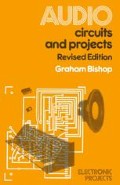Abstract
This chapter shows how the audio signals of the other chapters can be converted into light outputs using, for example, coloured lights for discos. The basis of sound-to-light units is the thyristor or triac which is a power switch that turns on several amperes of ac to an output lamp using a small input voltage to the gate. Once turned on, the thyristor or triac will stay on until its anode voltage falls below that of the cathode. Obviously this creates problems for dc operation, but for ac operation the alternating mains cycle from +300 V to −300 V or so performs this turning off every cycle. Thyristor circuits are well suited to mains operation. The triac is an adaptation of the thyristor which switches on both halves of the mains cycle, positive and negative. Thus the thyristor switches only on positive halves of the mains producing only half full output brightness on a lamp while the triac produces full output brightness.
Preview
Unable to display preview. Download preview PDF.
Copyright information
© 1985 Graham Bishop
About this chapter
Cite this chapter
Bishop, G. (1985). Disco Circuits. In: Audio Circuits and Projects. Macmillan Electronic Projects Series. Palgrave, London. https://doi.org/10.1007/978-1-349-07404-4_6
Download citation
DOI: https://doi.org/10.1007/978-1-349-07404-4_6
Publisher Name: Palgrave, London
Print ISBN: 978-0-333-37221-0
Online ISBN: 978-1-349-07404-4
eBook Packages: EngineeringEngineering (R0)

